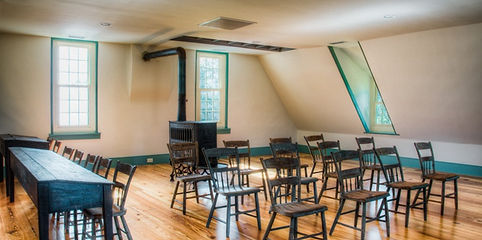Our Meeting House
Camden Friends Meeting House was built in 1805, on land donated by Jonathan and Patience Hunn. The Meeting House is unique among Friends’ places of worship by reason of its style of architecture. It is without porches, has double doors at the front, and smaller ones at the rear; and it is noticeable for its gambrel roof, called a “hiproof” in olden times; with its dormer windows on each of the east and west sides.
These windows were purposely designed for lighting the upper floor, where a school was kept from 1805 until about 1880. Most of the original desks and benches are still there along with the blackboard and a unique, old fashioned ten-plate stove manufactured in Wrightsville, PA. Interestingly, a partitioned panel between the meeting room and the stairway leading to the schoolroom can be dropped into a specially-constructed groove. This was used to provide extra seating space on the steps at times of an overfilled meeting.

On a post in the middle of the meeting room is a case containing a diagram of the adjacent burial ground and the Book of Registration of those buried there. The bricks from which it was built were made in 1802 from clay taken from the soil in the back where the structure now stands.


The old schoolroom on the upper floor of the Meeting House

The Gathering Place and Grounds:
An annex building adjacent to the Meeting House was constructed in 1959. Having outgrown the Annex, the Meeting built a new, environmentally responsible building in 2009. This building is known as the Gathering Place, where we gather for fellowship and other meetings.


Attenders are invited to the Gathering Place following Worship for fellowship and refreshments
The grounds surrounding the Meeting House and Gathering Place are landscaped in a natural design, including many native plants and featuring benches that provide space for quiet reflection.

The Burial Ground:
The oldest stone in the adjoining burial ground is that of Jonathan H. Jenkins, who died on August 11, 1837. John Hunn Jr., Governor of Delaware from 1901-1905, is also buried there, as is his father John Hunn, chief engineer of the Underground Railroad in Delaware.
Also present is a memorial stone to Warner Mifflin, one of Delaware’s prominent abolitionists. This stone was originally set up in Murderkill/Motherkill Burial Ground near Magnolia, where he is buried in an unmarked grave. When Murderkill Burial Ground became neglected the stone was moved to its present location in 1937.
